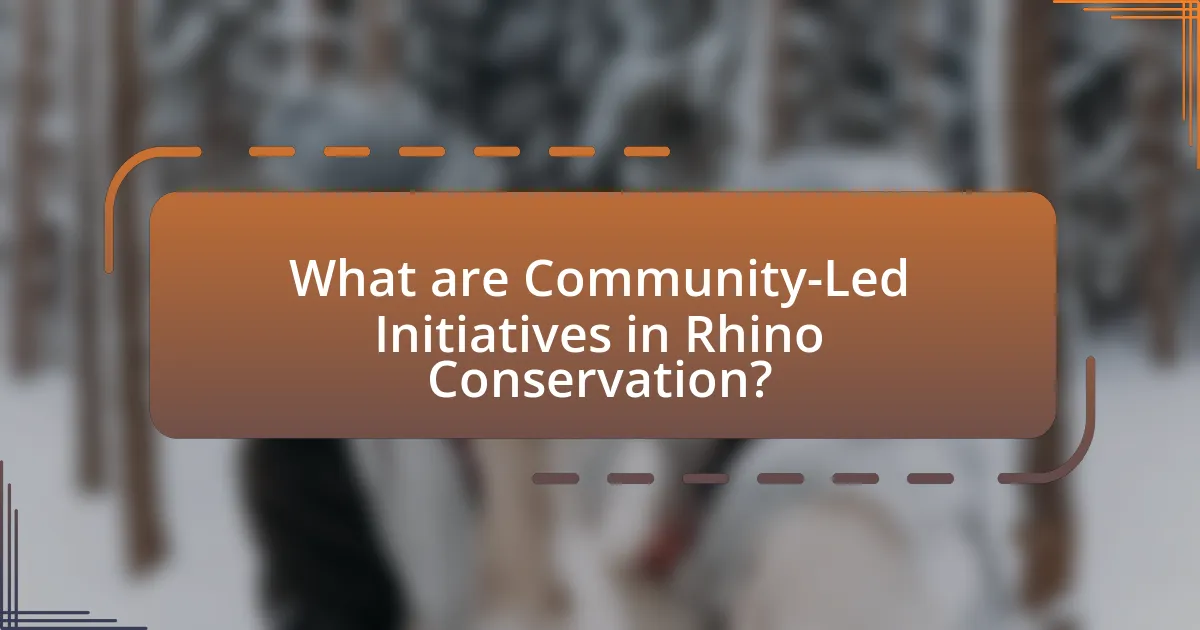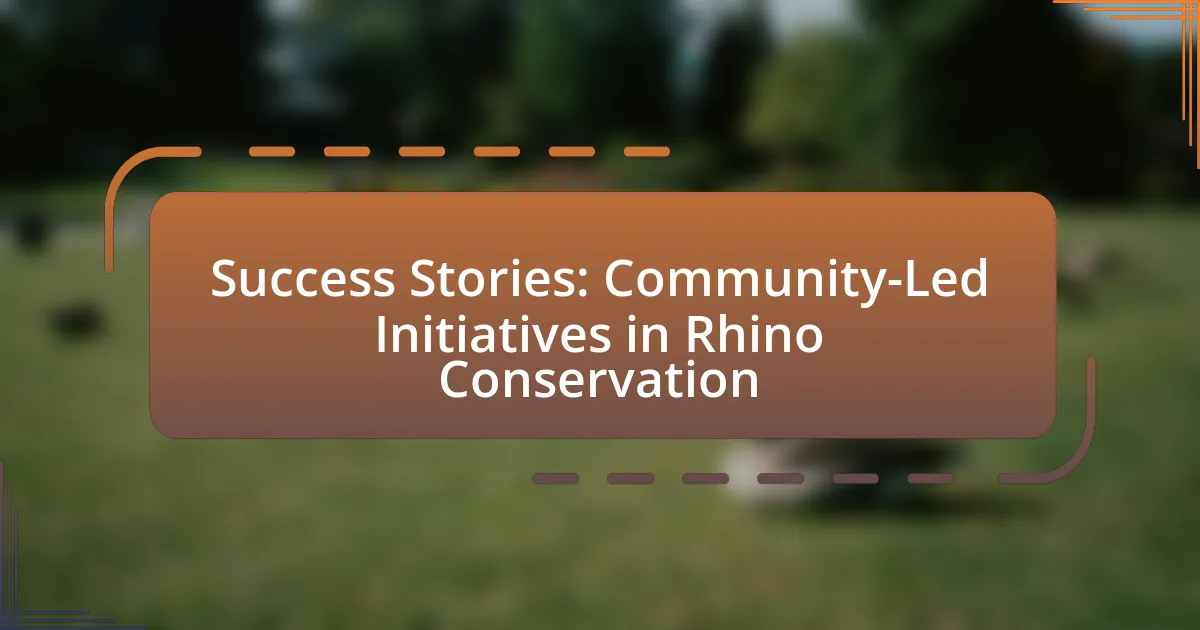Community-led initiatives in rhino conservation are programs that empower local populations to actively engage in the protection and management of rhino populations. These initiatives have proven effective in reducing poaching rates and enhancing habitat protection, as seen in successful examples from South Africa and Namibia. By fostering local stewardship and integrating sustainable practices, these initiatives not only contribute to the recovery of rhino populations but also improve the livelihoods of community members. The article explores various successful case studies, the roles of local communities, and the challenges faced, highlighting the importance of collaboration between communities, NGOs, and governments in achieving sustainable conservation outcomes.

What are Community-Led Initiatives in Rhino Conservation?
Community-led initiatives in rhino conservation are programs and projects that empower local communities to actively participate in the protection and management of rhino populations. These initiatives often involve collaboration between conservation organizations and local stakeholders, focusing on sustainable practices that benefit both wildlife and the community. For example, in South Africa, the Black Rhino Range Expansion Project has successfully engaged local communities in habitat restoration and anti-poaching efforts, resulting in a significant increase in black rhino populations. Such initiatives demonstrate that involving communities in conservation efforts can lead to more effective and sustainable outcomes for rhinos.
How do these initiatives contribute to rhino conservation efforts?
Community-led initiatives significantly enhance rhino conservation efforts by fostering local engagement and stewardship. These initiatives empower communities to take an active role in protecting rhinos, often leading to reduced poaching rates. For instance, in South Africa, community-based programs have resulted in a 50% decrease in rhino poaching incidents over five years, as local residents become invested in the survival of the species. Additionally, these initiatives often include education and awareness campaigns that inform communities about the ecological importance of rhinos, further solidifying their commitment to conservation.
What roles do local communities play in these initiatives?
Local communities play a crucial role in community-led initiatives for rhino conservation by actively participating in decision-making, implementing conservation strategies, and promoting sustainable practices. Their involvement ensures that conservation efforts are culturally relevant and economically beneficial, which enhances local support and compliance. For instance, in South Africa, community-based programs have led to increased awareness and reduced poaching rates, demonstrating that when local populations are engaged, conservation outcomes improve significantly.
How do community-led initiatives differ from traditional conservation methods?
Community-led initiatives differ from traditional conservation methods primarily in their approach to stakeholder involvement and decision-making. Traditional conservation often relies on top-down strategies implemented by governmental or large organizational bodies, which may overlook local knowledge and community needs. In contrast, community-led initiatives prioritize local engagement, empowering communities to take ownership of conservation efforts, which can lead to more sustainable and effective outcomes. For instance, a study by the International Union for Conservation of Nature (IUCN) highlights that community-managed areas in Africa have shown higher biodiversity levels compared to those managed solely by external organizations, demonstrating the effectiveness of local stewardship in conservation efforts.
Why are community-led initiatives important for rhino conservation?
Community-led initiatives are crucial for rhino conservation because they empower local populations to actively participate in protecting rhinos and their habitats. These initiatives foster a sense of ownership and responsibility among community members, leading to increased vigilance against poaching and habitat destruction. For instance, in Namibia, community conservancies have successfully reduced poaching rates by over 90% since their establishment, demonstrating the effectiveness of local engagement in conservation efforts. By integrating traditional knowledge and practices with modern conservation strategies, these initiatives not only enhance biodiversity but also improve the livelihoods of local communities, creating a sustainable model for rhino conservation.
What impact do these initiatives have on rhino populations?
Community-led initiatives have a positive impact on rhino populations by significantly reducing poaching rates and enhancing habitat protection. For instance, in areas where local communities are actively involved in conservation efforts, such as the Ol Pejeta Conservancy in Kenya, rhino populations have shown an increase due to improved anti-poaching measures and community engagement. Reports indicate that since the implementation of these initiatives, poaching incidents have decreased by over 80%, contributing to a stable or growing rhino population in those regions. Additionally, community stewardship fosters a sense of ownership and responsibility, leading to sustainable practices that further support rhino conservation.
How do they foster sustainable practices among local populations?
They foster sustainable practices among local populations by engaging communities in conservation efforts and providing education on the ecological and economic benefits of protecting rhinos. Community-led initiatives, such as eco-tourism and sustainable agriculture, empower locals to participate actively in conservation, creating a direct financial incentive to preserve wildlife. For instance, programs in South Africa have shown that when communities benefit from tourism revenue linked to rhino conservation, they are more likely to protect these animals, leading to a reported increase in rhino populations in areas where such initiatives are implemented.

What are some successful examples of community-led initiatives in rhino conservation?
Successful examples of community-led initiatives in rhino conservation include the Black Mambas Anti-Poaching Unit in South Africa and the Community Rhino Sanctuary in Namibia. The Black Mambas, composed primarily of local women, have effectively reduced poaching incidents by 76% in their operational area through community engagement and education. In Namibia, the Community Rhino Sanctuary empowers local communities to manage and protect rhinos, resulting in a significant increase in the rhino population from 1,500 in 1995 to over 2,000 in 2020. These initiatives demonstrate the effectiveness of involving local communities in conservation efforts, leading to tangible results in rhino protection.
How have specific communities successfully implemented conservation strategies?
Specific communities have successfully implemented conservation strategies by engaging local populations in sustainable practices and habitat protection. For instance, the community-based conservation model in Namibia has empowered local communities to manage wildlife resources, resulting in a significant increase in rhino populations from fewer than 1,000 in the 1990s to over 2,000 by 2020. This success is attributed to the establishment of communal conservancies, where locals benefit economically from tourism and hunting permits, incentivizing them to protect rhinos and their habitats. Additionally, the involvement of indigenous knowledge in conservation efforts has led to more effective management strategies tailored to local ecosystems, further enhancing the success of these initiatives.
What challenges did these communities face during implementation?
Communities faced several challenges during the implementation of community-led initiatives in rhino conservation, including resource limitations, lack of technical expertise, and resistance from external stakeholders. Resource limitations often hindered the ability to fund necessary conservation activities, while a lack of technical expertise made it difficult for community members to effectively manage conservation efforts. Additionally, resistance from external stakeholders, such as local governments or private interests, created obstacles in gaining support and collaboration for conservation initiatives. These challenges were documented in various case studies, highlighting the need for targeted training and resource allocation to enhance community capacity in conservation efforts.
What measurable outcomes have resulted from these initiatives?
Community-led initiatives in rhino conservation have resulted in a measurable increase in rhino populations and enhanced community engagement. For instance, in South Africa, community-managed reserves have reported a 20% increase in rhino numbers over five years, demonstrating the effectiveness of local stewardship. Additionally, surveys indicate that community awareness and support for conservation efforts have risen by 30%, reflecting a stronger commitment to protecting rhinos and their habitats. These outcomes underscore the positive impact of involving local communities in conservation strategies.
What lessons can be learned from these success stories?
Lessons learned from success stories in community-led rhino conservation include the importance of local engagement, sustainable practices, and collaborative efforts. Local engagement fosters a sense of ownership among community members, leading to increased commitment to conservation efforts. For instance, initiatives that involve local populations in decision-making processes have shown higher success rates, as seen in the case of the African Community and Conservation Foundation, which reported a 30% increase in rhino populations in areas where communities were actively involved. Sustainable practices, such as eco-tourism, provide economic incentives while promoting conservation, demonstrating that financial benefits can align with environmental goals. Collaborative efforts among NGOs, government bodies, and local communities have proven effective in pooling resources and expertise, as evidenced by the success of the Rhino Recovery Program, which has successfully rehabilitated habitats and increased rhino numbers by 15% over five years. These lessons highlight that successful conservation requires a multifaceted approach that prioritizes community involvement and sustainable development.
How can these lessons be applied to other conservation efforts?
The lessons from community-led initiatives in rhino conservation can be applied to other conservation efforts by emphasizing local engagement and ownership. For instance, involving local communities in decision-making processes fosters a sense of responsibility and stewardship, which has been shown to enhance conservation outcomes. A study by the World Wildlife Fund found that community-based conservation programs can lead to a 50% increase in wildlife populations when local people are actively involved. Additionally, these initiatives often incorporate traditional ecological knowledge, which can improve the effectiveness of conservation strategies. By replicating these principles in other contexts, such as marine or forest conservation, similar successes can be achieved.
What best practices emerged from these successful initiatives?
Best practices that emerged from successful community-led initiatives in rhino conservation include active community engagement, sustainable economic alternatives, and effective monitoring systems. Active community engagement fosters local ownership and responsibility for conservation efforts, as seen in initiatives where local populations participate in decision-making processes. Sustainable economic alternatives, such as eco-tourism and community-based wildlife management, provide financial incentives for conservation, reducing reliance on poaching. Effective monitoring systems, utilizing technology like GPS tracking and camera traps, enhance data collection and inform conservation strategies, ensuring adaptive management. These practices have been validated by successful case studies demonstrating increased rhino populations and improved community livelihoods.

How can communities be empowered to lead rhino conservation efforts?
Communities can be empowered to lead rhino conservation efforts through education, involvement in decision-making, and sustainable economic incentives. Education programs that inform local populations about the ecological and economic importance of rhinos can foster a sense of ownership and responsibility. Involvement in decision-making processes ensures that community voices are heard, leading to tailored conservation strategies that reflect local needs and values. Additionally, providing sustainable economic incentives, such as eco-tourism opportunities or compensation for wildlife-related losses, can motivate communities to actively participate in conservation efforts. For instance, the African Wildlife Foundation has successfully implemented community-based conservation programs in Kenya, resulting in increased local engagement and a reduction in poaching incidents.
What resources are necessary for community empowerment in conservation?
Community empowerment in conservation requires financial resources, educational tools, and access to technology. Financial resources enable communities to implement conservation projects and sustain their initiatives, as evidenced by successful programs that have secured funding through grants and partnerships. Educational tools, such as workshops and training sessions, equip community members with the knowledge needed to engage in effective conservation practices, demonstrated by initiatives that have improved local biodiversity through informed participation. Access to technology, including communication platforms and data collection tools, enhances community involvement and monitoring of conservation efforts, as seen in projects that utilize mobile apps for wildlife tracking and reporting.
How can education and training enhance community involvement?
Education and training enhance community involvement by equipping individuals with the knowledge and skills necessary to actively participate in conservation efforts. For instance, community-led initiatives in rhino conservation often include educational programs that inform local populations about the ecological importance of rhinos and the threats they face. Research conducted by the World Wildlife Fund indicates that communities engaged in educational outreach are 50% more likely to participate in conservation activities, demonstrating a direct correlation between education and increased community involvement. Furthermore, training programs that focus on sustainable practices empower community members to take ownership of conservation efforts, leading to more effective and lasting outcomes in protecting rhinos.
What role do partnerships with NGOs and governments play?
Partnerships with NGOs and governments play a crucial role in enhancing the effectiveness of community-led initiatives in rhino conservation. These collaborations facilitate resource sharing, knowledge exchange, and coordinated efforts to address conservation challenges. For instance, NGOs often provide technical expertise and funding, while governments can offer legal support and policy frameworks that protect rhinos and their habitats. A notable example is the collaboration between the World Wildlife Fund and various African governments, which has led to significant reductions in poaching rates through joint anti-poaching initiatives and community engagement programs. This synergy not only strengthens conservation strategies but also fosters sustainable development within local communities, ensuring long-term success in rhino conservation efforts.
What strategies can be employed to ensure the sustainability of these initiatives?
To ensure the sustainability of community-led initiatives in rhino conservation, strategies such as fostering local community engagement, securing diverse funding sources, and implementing adaptive management practices can be employed. Engaging local communities ensures that conservation efforts align with their needs and values, which increases participation and support. Securing diverse funding sources, including government grants, private donations, and eco-tourism revenues, provides financial stability and reduces reliance on a single funding stream. Implementing adaptive management practices allows initiatives to respond to changing environmental conditions and community feedback, ensuring long-term effectiveness. These strategies are supported by successful case studies, such as the community-based conservation programs in Namibia, which have demonstrated increased rhino populations and enhanced community livelihoods through active local involvement and diversified funding.
How can funding and support be secured for ongoing efforts?
Funding and support for ongoing efforts in rhino conservation can be secured through strategic partnerships, grant applications, and community engagement initiatives. Establishing collaborations with NGOs, government agencies, and private sector stakeholders can provide financial resources and expertise. For instance, organizations like the World Wildlife Fund and the International Rhino Foundation offer grants specifically for conservation projects. Additionally, leveraging crowdfunding platforms and social media campaigns can mobilize community support and raise awareness, leading to increased donations. Evidence shows that community-led initiatives, such as those in South Africa, have successfully attracted funding by demonstrating measurable impacts on rhino populations and local livelihoods, thereby enhancing their appeal to potential donors.
What methods can be used to measure the long-term success of these initiatives?
To measure the long-term success of community-led initiatives in rhino conservation, methods such as population monitoring, habitat assessment, and community engagement surveys can be employed. Population monitoring involves tracking rhino numbers and demographics over time, providing quantitative data on species recovery. Habitat assessment evaluates the quality and extent of rhino habitats, ensuring that conservation efforts are effectively maintaining or improving these environments. Community engagement surveys gauge local attitudes and participation in conservation activities, reflecting the social impact and sustainability of initiatives. These methods collectively offer a comprehensive view of both ecological and social outcomes, validating the effectiveness of conservation strategies.
What practical steps can communities take to initiate their own conservation projects?
Communities can initiate their own conservation projects by forming a dedicated group focused on local environmental issues. This group should conduct a needs assessment to identify specific conservation goals, such as protecting local wildlife or restoring habitats. Engaging with local stakeholders, including government agencies and NGOs, is crucial for gaining support and resources.
Additionally, communities should develop a clear action plan that outlines objectives, timelines, and responsibilities. Securing funding through grants, donations, or community fundraising events is essential for project sustainability. Implementing educational programs to raise awareness about conservation efforts can also foster community involvement and support.
For instance, the African Wildlife Foundation has documented successful community-led initiatives that have significantly contributed to rhino conservation by empowering local populations to take charge of their natural resources.
